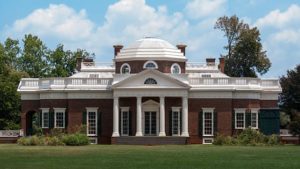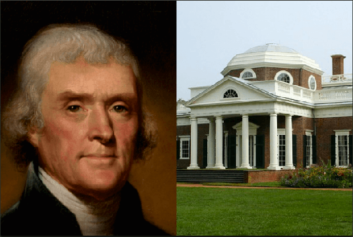
Sally Hemings’ bedroom was located adjacent to Thomas Jefferson’s at the Montocello mansion. (Photo by Rick Stillin
Archaeologists made an astonishing discovery at Thomas Jefferson’s Monticello mansion this week, as they unearthed the former living quarters of Sally Hemings, the enslaved Black woman believed to have given birth to Jefferson’s six children.
“This discovery gives us a sense of how enslaved people were living,” Gardiner Hallock, the director of restoration at Jefferson’s mountaintop plantation, said. “Some of Sally’s children may have been born in this room. “It’s important because it shows Sally as a human being — a mother, daughter and sister — and brings out the relationships in her life.”
Hemings’ living quarters, a 14-by-13-foot room located adjacent to Jefferson’s bedroom, had gone unnoticed for decades. In 1941, the space was turned into a men’s bathroom, adding to the long list of insults to the enslaved woman’s legacy.
Mia Magruder Dammann, a spokeswoman for Monticello, told NBCBLK that the earlier bathrooms had become too small to accommodate the large number of visitors at the estate, so a local restoration architect renovated and enlarged the bathrooms in 1967. More recently, however, historians analyzed a decades-old description given by one of Jefferson’s grandsons that showed Hemings’ room in the mansion’s South Wing.
That’s when archaeologists started digging.
“For the first time at Monticello, we have a physical space dedicated to Sally Hemings and her life,” Dammann said. “It’s significant because it connects the entire African-American arch at Monticello.”
Hemings’ living quarters revealed the original brick hearth and fireplace, the brick structure for a stove and original floors dating back to the early 1800s, according to Fraser Neiman, the director of archaeology at Monticello. The shocking discovery comes as the 5,000-acre Virginia plantation undergoes a multi-year, $35-million restoration project aimed at putting the estate back to how Jefferson would’ve known it.
Through the appropriately dubbed “Mountaintop Project,” historians also hope to tell the stories of the people, both enslaved and free, who lived and worked on the plantation.
While there have been hundreds of books written on Jefferson and his family, very few details have ever been written about Hemings — aside from the fact that she was likely part of a forced sexual relationship with the former president. NBCBLK reports that there are only four known descriptions about the enslaved woman.
In one characterization, enslaved blacksmith Isaac Granger described Hemings as “mighty near white … very handsome, long straight hair down her back.”
After several decades, Hemings’ room will finally be restored and eventually put on display for the public to see, NBCBLK reported. Curators also are working to incorporate Hemings into Jefferson’s comprehensive life story, which would dispel old newspaper accounts dubbing the enslaved womann as the third president’s “concubine.”
“As an African-American descendant, I have mixed feelings,” Gayle Jessup White, Monticello’s Community Engagement Officer and a descendant of the Hemings and Jefferson families, said. “I’m appreciative of the work that my colleagues are doing at Monticello because this is an American story, an important story. But for too long, our history has been ignored. Some people still don’t want to admit that the Civil War was fought over slavery.
“We need to face history head on and face the blemish of slavery and that’s what we’re doing at Monticello,” she concluded.


